Financial Accounting Assignment: Trial Balance & Financial Statements
VerifiedAdded on 2023/01/12
|24
|5045
|38
Homework Assignment
AI Summary
This assignment focuses on financial accounting principles, including the preparation of a trial balance, journal entries, and financial statements. The solution begins with a trial balance as of March 31, 2020, followed by journal entries for April 2020. Ledger balances are presented, and a second trial balance is prepared as of April 30, 2020. The assignment analyzes transactions, demonstrating how they impact the trial balance. Finally, the trial balance figures are applied to illustrate the components of financial statements, including the income statement, balance sheet, and cash flow statement. The report also explains the importance of each financial statement, and their use to make decisions, in addition to the role they play in providing critical financial information to business stakeholders.
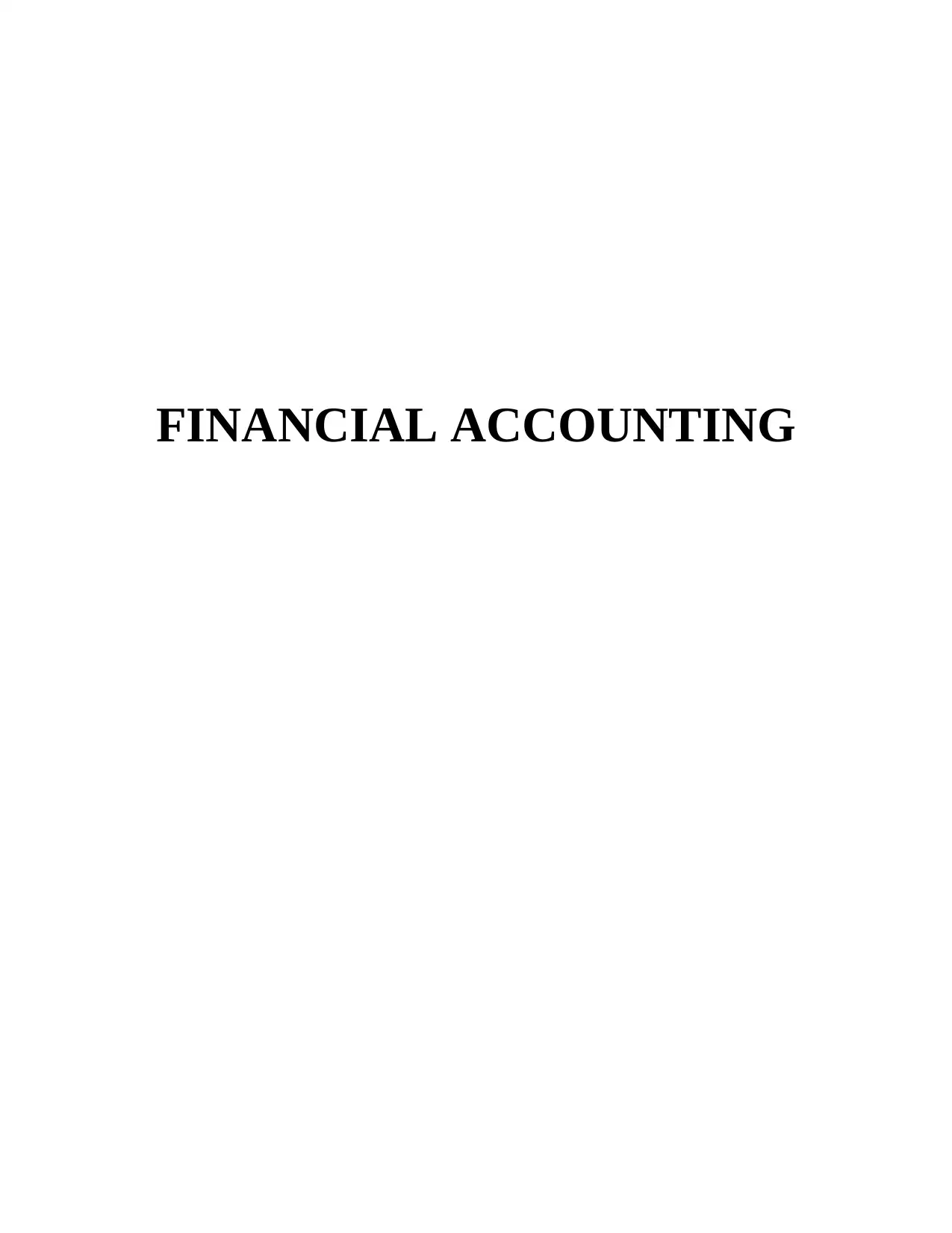
FINANCIAL ACCOUNTING
Paraphrase This Document
Need a fresh take? Get an instant paraphrase of this document with our AI Paraphraser
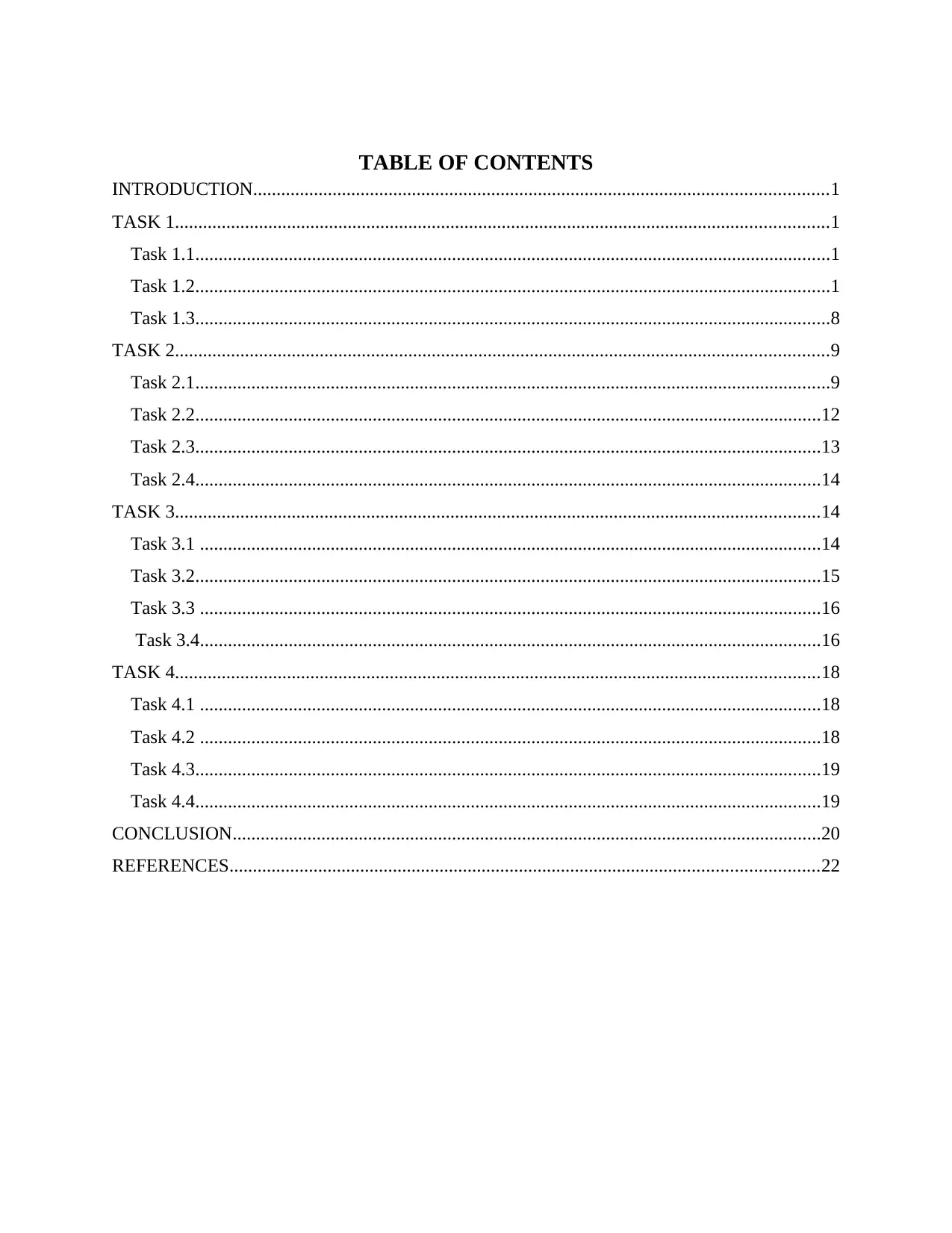
TABLE OF CONTENTS
INTRODUCTION...........................................................................................................................1
TASK 1............................................................................................................................................1
Task 1.1........................................................................................................................................1
Task 1.2........................................................................................................................................1
Task 1.3........................................................................................................................................8
TASK 2............................................................................................................................................9
Task 2.1........................................................................................................................................9
Task 2.2......................................................................................................................................12
Task 2.3......................................................................................................................................13
Task 2.4......................................................................................................................................14
TASK 3..........................................................................................................................................14
Task 3.1 .....................................................................................................................................14
Task 3.2......................................................................................................................................15
Task 3.3 .....................................................................................................................................16
Task 3.4.....................................................................................................................................16
TASK 4..........................................................................................................................................18
Task 4.1 .....................................................................................................................................18
Task 4.2 .....................................................................................................................................18
Task 4.3......................................................................................................................................19
Task 4.4......................................................................................................................................19
CONCLUSION..............................................................................................................................20
REFERENCES..............................................................................................................................22
INTRODUCTION...........................................................................................................................1
TASK 1............................................................................................................................................1
Task 1.1........................................................................................................................................1
Task 1.2........................................................................................................................................1
Task 1.3........................................................................................................................................8
TASK 2............................................................................................................................................9
Task 2.1........................................................................................................................................9
Task 2.2......................................................................................................................................12
Task 2.3......................................................................................................................................13
Task 2.4......................................................................................................................................14
TASK 3..........................................................................................................................................14
Task 3.1 .....................................................................................................................................14
Task 3.2......................................................................................................................................15
Task 3.3 .....................................................................................................................................16
Task 3.4.....................................................................................................................................16
TASK 4..........................................................................................................................................18
Task 4.1 .....................................................................................................................................18
Task 4.2 .....................................................................................................................................18
Task 4.3......................................................................................................................................19
Task 4.4......................................................................................................................................19
CONCLUSION..............................................................................................................................20
REFERENCES..............................................................................................................................22
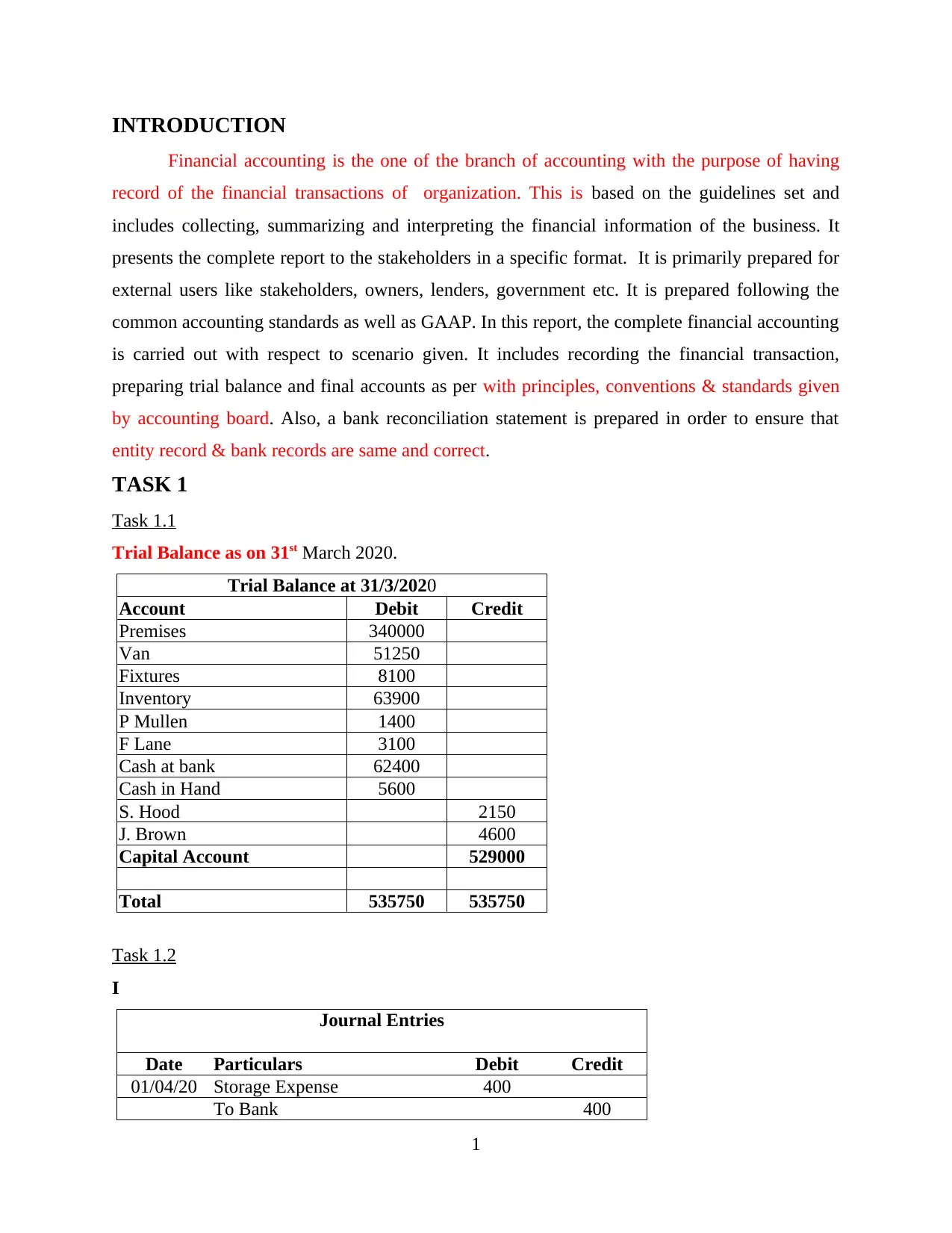
INTRODUCTION
Financial accounting is the one of the branch of accounting with the purpose of having
record of the financial transactions of organization. This is based on the guidelines set and
includes collecting, summarizing and interpreting the financial information of the business. It
presents the complete report to the stakeholders in a specific format. It is primarily prepared for
external users like stakeholders, owners, lenders, government etc. It is prepared following the
common accounting standards as well as GAAP. In this report, the complete financial accounting
is carried out with respect to scenario given. It includes recording the financial transaction,
preparing trial balance and final accounts as per with principles, conventions & standards given
by accounting board. Also, a bank reconciliation statement is prepared in order to ensure that
entity record & bank records are same and correct.
TASK 1
Task 1.1
Trial Balance as on 31st March 2020.
Trial Balance at 31/3/2020
Account Debit Credit
Premises 340000
Van 51250
Fixtures 8100
Inventory 63900
P Mullen 1400
F Lane 3100
Cash at bank 62400
Cash in Hand 5600
S. Hood 2150
J. Brown 4600
Capital Account 529000
Total 535750 535750
Task 1.2
I
Journal Entries
Date Particulars Debit Credit
01/04/20 Storage Expense 400
To Bank 400
1
Financial accounting is the one of the branch of accounting with the purpose of having
record of the financial transactions of organization. This is based on the guidelines set and
includes collecting, summarizing and interpreting the financial information of the business. It
presents the complete report to the stakeholders in a specific format. It is primarily prepared for
external users like stakeholders, owners, lenders, government etc. It is prepared following the
common accounting standards as well as GAAP. In this report, the complete financial accounting
is carried out with respect to scenario given. It includes recording the financial transaction,
preparing trial balance and final accounts as per with principles, conventions & standards given
by accounting board. Also, a bank reconciliation statement is prepared in order to ensure that
entity record & bank records are same and correct.
TASK 1
Task 1.1
Trial Balance as on 31st March 2020.
Trial Balance at 31/3/2020
Account Debit Credit
Premises 340000
Van 51250
Fixtures 8100
Inventory 63900
P Mullen 1400
F Lane 3100
Cash at bank 62400
Cash in Hand 5600
S. Hood 2150
J. Brown 4600
Capital Account 529000
Total 535750 535750
Task 1.2
I
Journal Entries
Date Particulars Debit Credit
01/04/20 Storage Expense 400
To Bank 400
1
⊘ This is a preview!⊘
Do you want full access?
Subscribe today to unlock all pages.

Trusted by 1+ million students worldwide
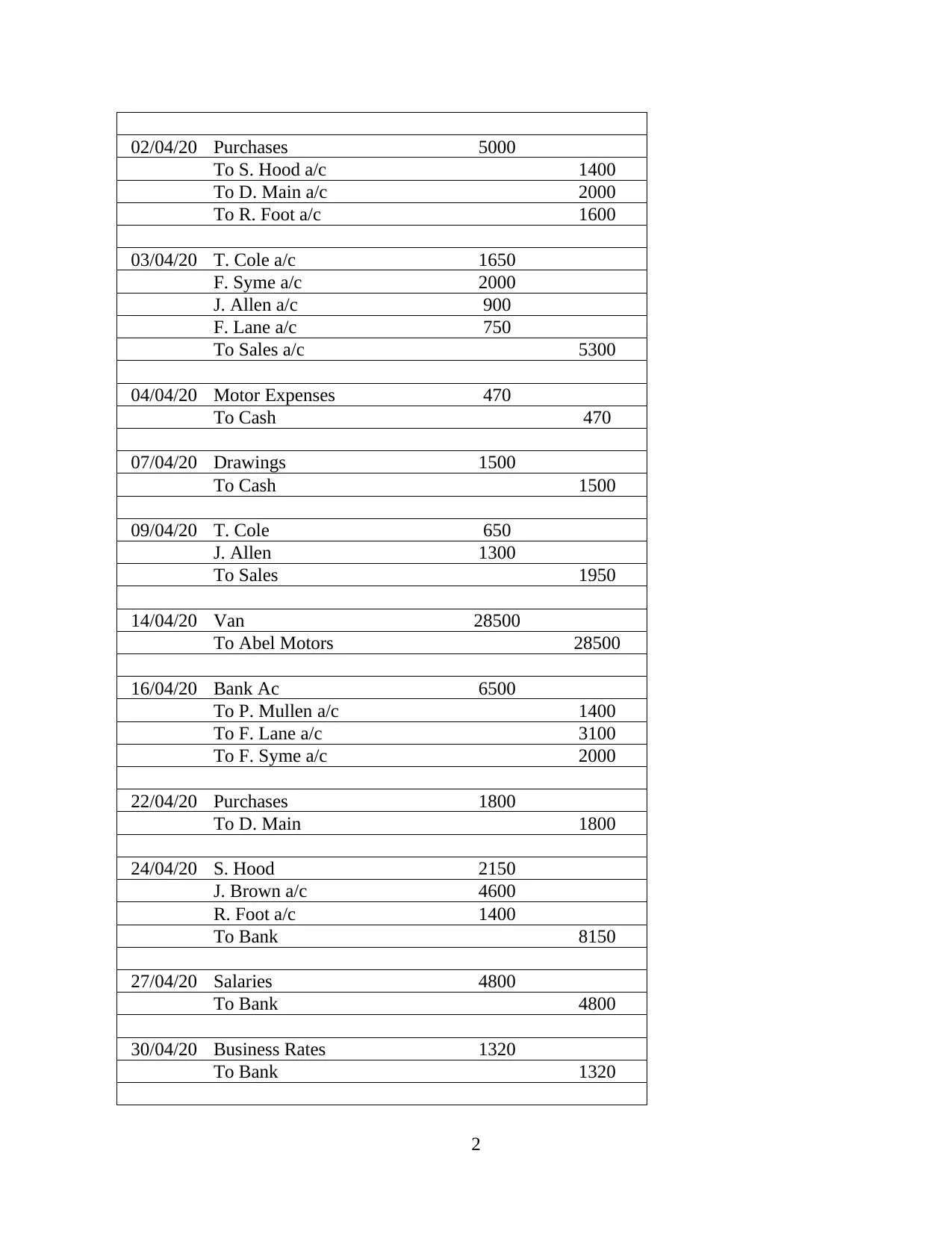
02/04/20 Purchases 5000
To S. Hood a/c 1400
To D. Main a/c 2000
To R. Foot a/c 1600
03/04/20 T. Cole a/c 1650
F. Syme a/c 2000
J. Allen a/c 900
F. Lane a/c 750
To Sales a/c 5300
04/04/20 Motor Expenses 470
To Cash 470
07/04/20 Drawings 1500
To Cash 1500
09/04/20 T. Cole 650
J. Allen 1300
To Sales 1950
14/04/20 Van 28500
To Abel Motors 28500
16/04/20 Bank Ac 6500
To P. Mullen a/c 1400
To F. Lane a/c 3100
To F. Syme a/c 2000
22/04/20 Purchases 1800
To D. Main 1800
24/04/20 S. Hood 2150
J. Brown a/c 4600
R. Foot a/c 1400
To Bank 8150
27/04/20 Salaries 4800
To Bank 4800
30/04/20 Business Rates 1320
To Bank 1320
2
To S. Hood a/c 1400
To D. Main a/c 2000
To R. Foot a/c 1600
03/04/20 T. Cole a/c 1650
F. Syme a/c 2000
J. Allen a/c 900
F. Lane a/c 750
To Sales a/c 5300
04/04/20 Motor Expenses 470
To Cash 470
07/04/20 Drawings 1500
To Cash 1500
09/04/20 T. Cole 650
J. Allen 1300
To Sales 1950
14/04/20 Van 28500
To Abel Motors 28500
16/04/20 Bank Ac 6500
To P. Mullen a/c 1400
To F. Lane a/c 3100
To F. Syme a/c 2000
22/04/20 Purchases 1800
To D. Main 1800
24/04/20 S. Hood 2150
J. Brown a/c 4600
R. Foot a/c 1400
To Bank 8150
27/04/20 Salaries 4800
To Bank 4800
30/04/20 Business Rates 1320
To Bank 1320
2
Paraphrase This Document
Need a fresh take? Get an instant paraphrase of this document with our AI Paraphraser
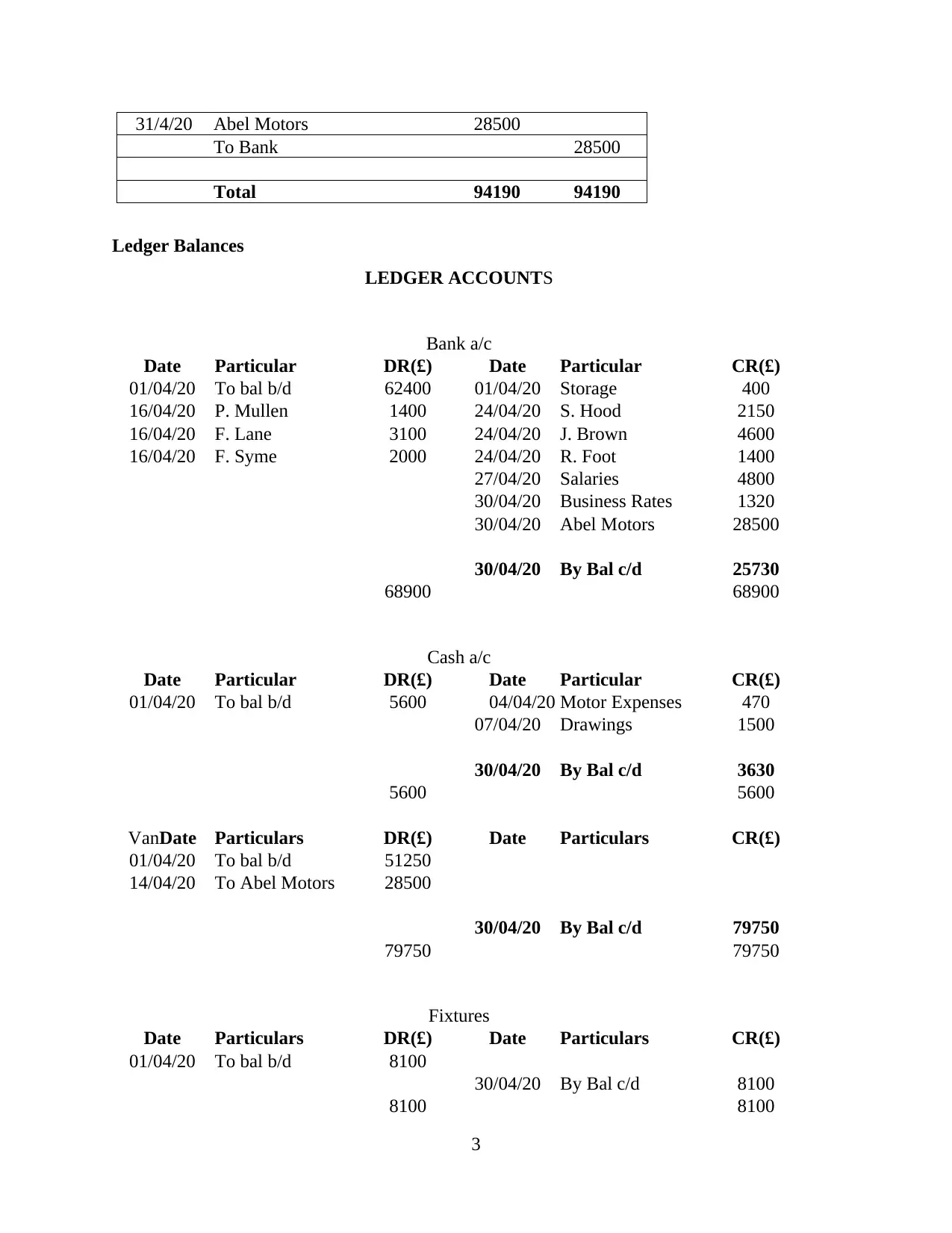
31/4/20 Abel Motors 28500
To Bank 28500
Total 94190 94190
Ledger Balances
LEDGER ACCOUNTS
Bank a/c
Date Particular DR(£) Date Particular CR(£)
01/04/20 To bal b/d 62400 01/04/20 Storage 400
16/04/20 P. Mullen 1400 24/04/20 S. Hood 2150
16/04/20 F. Lane 3100 24/04/20 J. Brown 4600
16/04/20 F. Syme 2000 24/04/20 R. Foot 1400
27/04/20 Salaries 4800
30/04/20 Business Rates 1320
30/04/20 Abel Motors 28500
30/04/20 By Bal c/d 25730
68900 68900
Cash a/c
Date Particular DR(£) Date Particular CR(£)
01/04/20 To bal b/d 5600 04/04/20 Motor Expenses 470
07/04/20 Drawings 1500
30/04/20 By Bal c/d 3630
5600 5600
VanDate Particulars DR(£) Date Particulars CR(£)
01/04/20 To bal b/d 51250
14/04/20 To Abel Motors 28500
30/04/20 By Bal c/d 79750
79750 79750
Fixtures
Date Particulars DR(£) Date Particulars CR(£)
01/04/20 To bal b/d 8100
30/04/20 By Bal c/d 8100
8100 8100
3
To Bank 28500
Total 94190 94190
Ledger Balances
LEDGER ACCOUNTS
Bank a/c
Date Particular DR(£) Date Particular CR(£)
01/04/20 To bal b/d 62400 01/04/20 Storage 400
16/04/20 P. Mullen 1400 24/04/20 S. Hood 2150
16/04/20 F. Lane 3100 24/04/20 J. Brown 4600
16/04/20 F. Syme 2000 24/04/20 R. Foot 1400
27/04/20 Salaries 4800
30/04/20 Business Rates 1320
30/04/20 Abel Motors 28500
30/04/20 By Bal c/d 25730
68900 68900
Cash a/c
Date Particular DR(£) Date Particular CR(£)
01/04/20 To bal b/d 5600 04/04/20 Motor Expenses 470
07/04/20 Drawings 1500
30/04/20 By Bal c/d 3630
5600 5600
VanDate Particulars DR(£) Date Particulars CR(£)
01/04/20 To bal b/d 51250
14/04/20 To Abel Motors 28500
30/04/20 By Bal c/d 79750
79750 79750
Fixtures
Date Particulars DR(£) Date Particulars CR(£)
01/04/20 To bal b/d 8100
30/04/20 By Bal c/d 8100
8100 8100
3
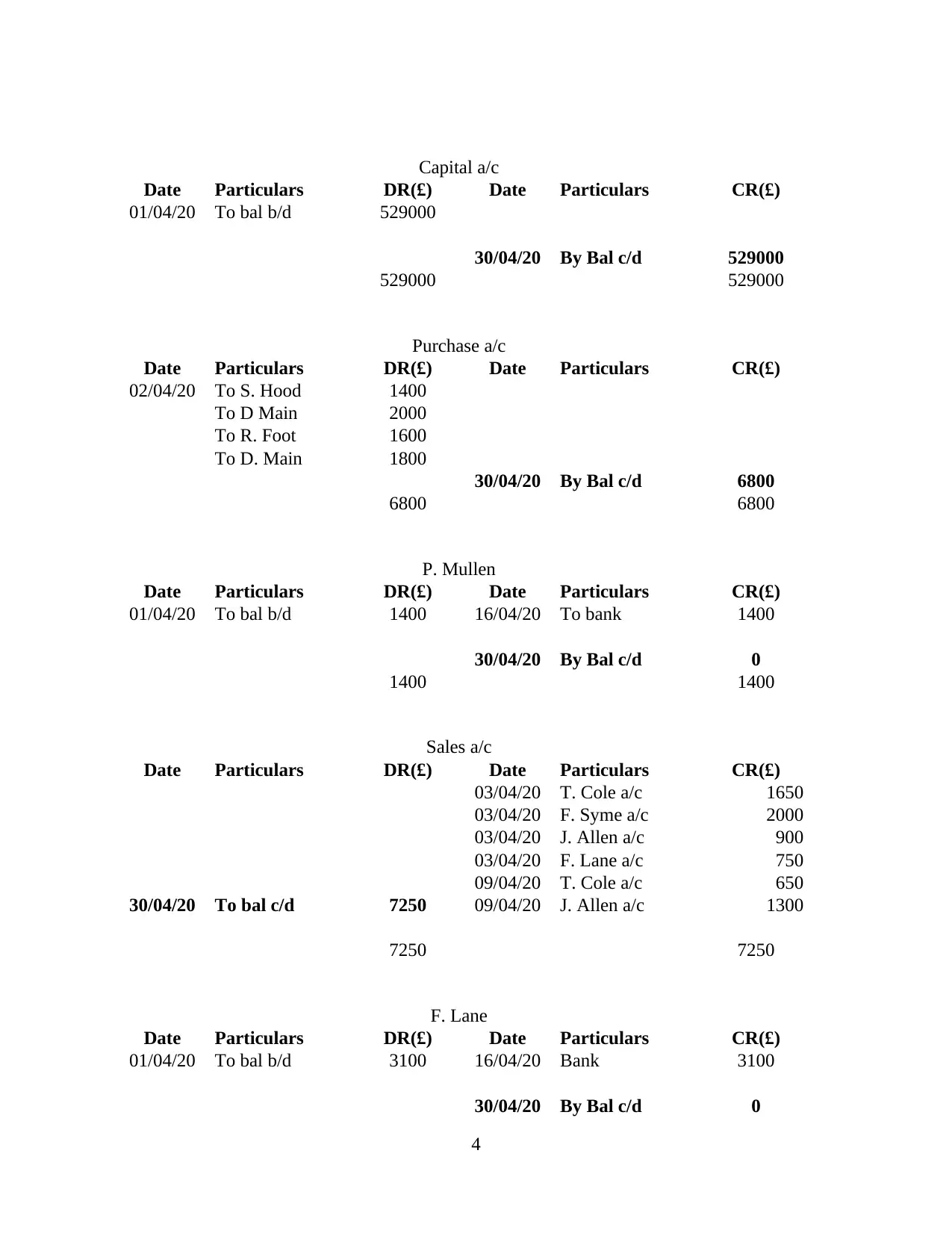
Capital a/c
Date Particulars DR(£) Date Particulars CR(£)
01/04/20 To bal b/d 529000
30/04/20 By Bal c/d 529000
529000 529000
Purchase a/c
Date Particulars DR(£) Date Particulars CR(£)
02/04/20 To S. Hood 1400
To D Main 2000
To R. Foot 1600
To D. Main 1800
30/04/20 By Bal c/d 6800
6800 6800
P. Mullen
Date Particulars DR(£) Date Particulars CR(£)
01/04/20 To bal b/d 1400 16/04/20 To bank 1400
30/04/20 By Bal c/d 0
1400 1400
Sales a/c
Date Particulars DR(£) Date Particulars CR(£)
03/04/20 T. Cole a/c 1650
03/04/20 F. Syme a/c 2000
03/04/20 J. Allen a/c 900
03/04/20 F. Lane a/c 750
09/04/20 T. Cole a/c 650
30/04/20 To bal c/d 7250 09/04/20 J. Allen a/c 1300
7250 7250
F. Lane
Date Particulars DR(£) Date Particulars CR(£)
01/04/20 To bal b/d 3100 16/04/20 Bank 3100
30/04/20 By Bal c/d 0
4
Date Particulars DR(£) Date Particulars CR(£)
01/04/20 To bal b/d 529000
30/04/20 By Bal c/d 529000
529000 529000
Purchase a/c
Date Particulars DR(£) Date Particulars CR(£)
02/04/20 To S. Hood 1400
To D Main 2000
To R. Foot 1600
To D. Main 1800
30/04/20 By Bal c/d 6800
6800 6800
P. Mullen
Date Particulars DR(£) Date Particulars CR(£)
01/04/20 To bal b/d 1400 16/04/20 To bank 1400
30/04/20 By Bal c/d 0
1400 1400
Sales a/c
Date Particulars DR(£) Date Particulars CR(£)
03/04/20 T. Cole a/c 1650
03/04/20 F. Syme a/c 2000
03/04/20 J. Allen a/c 900
03/04/20 F. Lane a/c 750
09/04/20 T. Cole a/c 650
30/04/20 To bal c/d 7250 09/04/20 J. Allen a/c 1300
7250 7250
F. Lane
Date Particulars DR(£) Date Particulars CR(£)
01/04/20 To bal b/d 3100 16/04/20 Bank 3100
30/04/20 By Bal c/d 0
4
⊘ This is a preview!⊘
Do you want full access?
Subscribe today to unlock all pages.

Trusted by 1+ million students worldwide
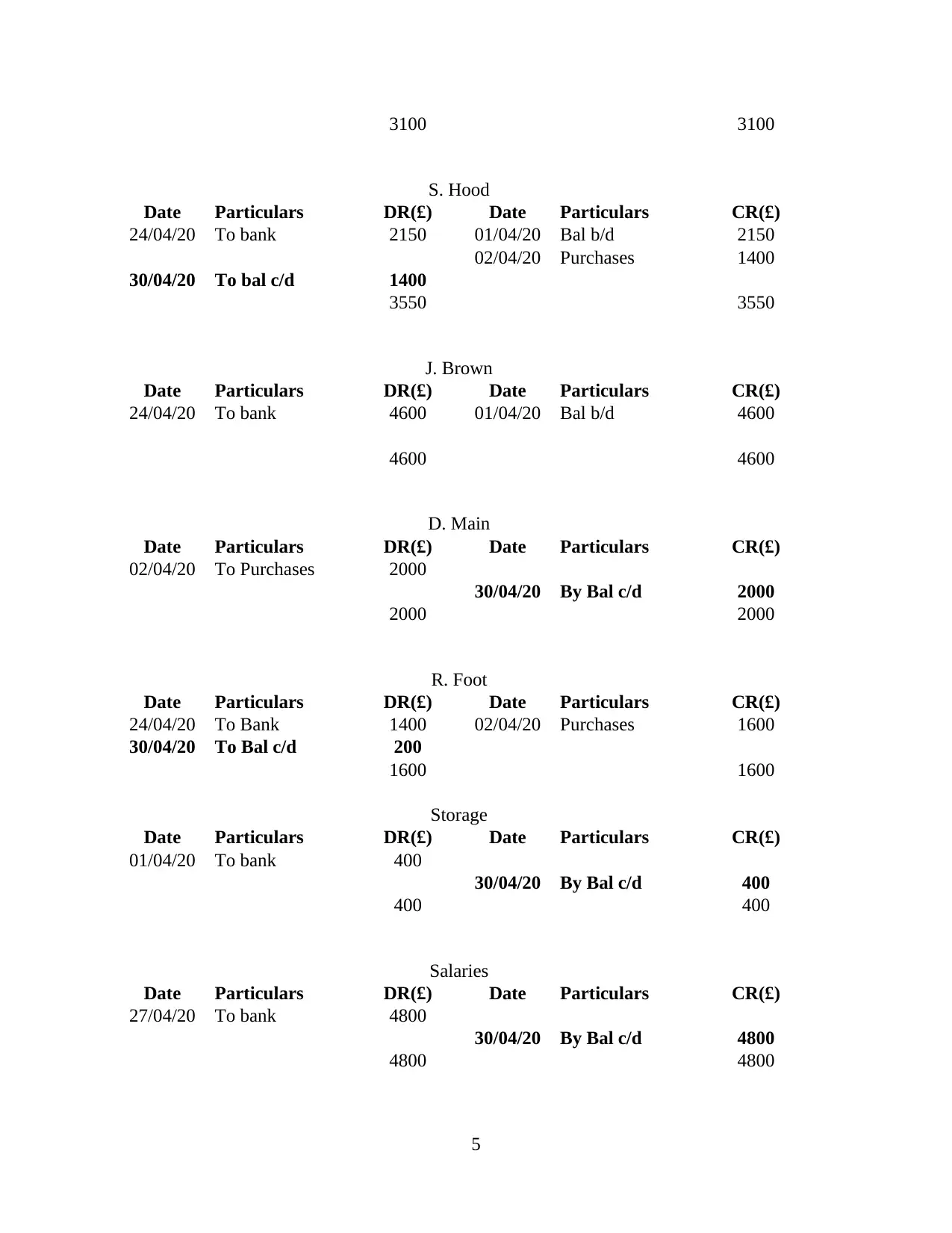
3100 3100
S. Hood
Date Particulars DR(£) Date Particulars CR(£)
24/04/20 To bank 2150 01/04/20 Bal b/d 2150
02/04/20 Purchases 1400
30/04/20 To bal c/d 1400
3550 3550
J. Brown
Date Particulars DR(£) Date Particulars CR(£)
24/04/20 To bank 4600 01/04/20 Bal b/d 4600
4600 4600
D. Main
Date Particulars DR(£) Date Particulars CR(£)
02/04/20 To Purchases 2000
30/04/20 By Bal c/d 2000
2000 2000
R. Foot
Date Particulars DR(£) Date Particulars CR(£)
24/04/20 To Bank 1400 02/04/20 Purchases 1600
30/04/20 To Bal c/d 200
1600 1600
Storage
Date Particulars DR(£) Date Particulars CR(£)
01/04/20 To bank 400
30/04/20 By Bal c/d 400
400 400
Salaries
Date Particulars DR(£) Date Particulars CR(£)
27/04/20 To bank 4800
30/04/20 By Bal c/d 4800
4800 4800
5
S. Hood
Date Particulars DR(£) Date Particulars CR(£)
24/04/20 To bank 2150 01/04/20 Bal b/d 2150
02/04/20 Purchases 1400
30/04/20 To bal c/d 1400
3550 3550
J. Brown
Date Particulars DR(£) Date Particulars CR(£)
24/04/20 To bank 4600 01/04/20 Bal b/d 4600
4600 4600
D. Main
Date Particulars DR(£) Date Particulars CR(£)
02/04/20 To Purchases 2000
30/04/20 By Bal c/d 2000
2000 2000
R. Foot
Date Particulars DR(£) Date Particulars CR(£)
24/04/20 To Bank 1400 02/04/20 Purchases 1600
30/04/20 To Bal c/d 200
1600 1600
Storage
Date Particulars DR(£) Date Particulars CR(£)
01/04/20 To bank 400
30/04/20 By Bal c/d 400
400 400
Salaries
Date Particulars DR(£) Date Particulars CR(£)
27/04/20 To bank 4800
30/04/20 By Bal c/d 4800
4800 4800
5
Paraphrase This Document
Need a fresh take? Get an instant paraphrase of this document with our AI Paraphraser
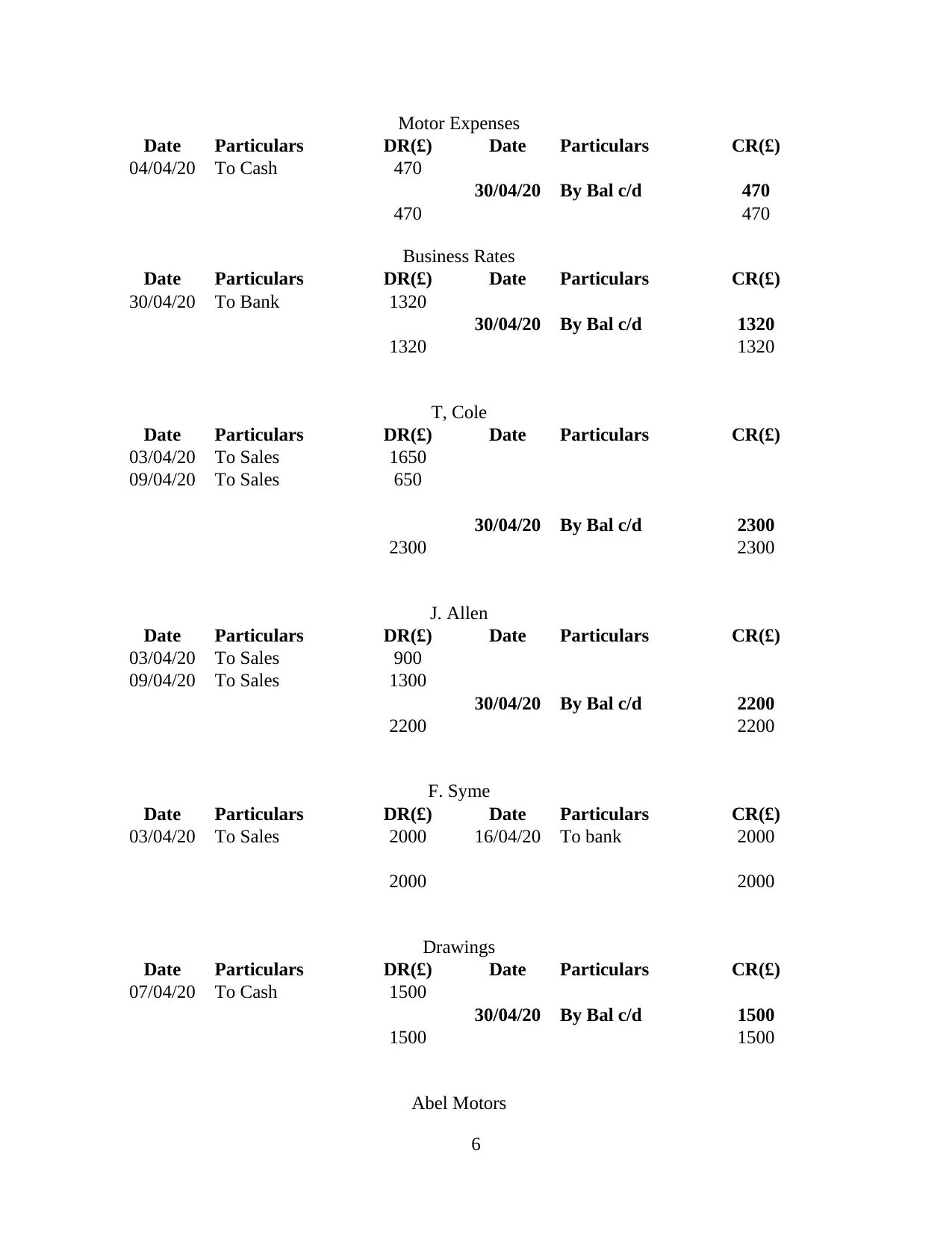
Motor Expenses
Date Particulars DR(£) Date Particulars CR(£)
04/04/20 To Cash 470
30/04/20 By Bal c/d 470
470 470
Business Rates
Date Particulars DR(£) Date Particulars CR(£)
30/04/20 To Bank 1320
30/04/20 By Bal c/d 1320
1320 1320
T, Cole
Date Particulars DR(£) Date Particulars CR(£)
03/04/20 To Sales 1650
09/04/20 To Sales 650
30/04/20 By Bal c/d 2300
2300 2300
J. Allen
Date Particulars DR(£) Date Particulars CR(£)
03/04/20 To Sales 900
09/04/20 To Sales 1300
30/04/20 By Bal c/d 2200
2200 2200
F. Syme
Date Particulars DR(£) Date Particulars CR(£)
03/04/20 To Sales 2000 16/04/20 To bank 2000
2000 2000
Drawings
Date Particulars DR(£) Date Particulars CR(£)
07/04/20 To Cash 1500
30/04/20 By Bal c/d 1500
1500 1500
Abel Motors
6
Date Particulars DR(£) Date Particulars CR(£)
04/04/20 To Cash 470
30/04/20 By Bal c/d 470
470 470
Business Rates
Date Particulars DR(£) Date Particulars CR(£)
30/04/20 To Bank 1320
30/04/20 By Bal c/d 1320
1320 1320
T, Cole
Date Particulars DR(£) Date Particulars CR(£)
03/04/20 To Sales 1650
09/04/20 To Sales 650
30/04/20 By Bal c/d 2300
2300 2300
J. Allen
Date Particulars DR(£) Date Particulars CR(£)
03/04/20 To Sales 900
09/04/20 To Sales 1300
30/04/20 By Bal c/d 2200
2200 2200
F. Syme
Date Particulars DR(£) Date Particulars CR(£)
03/04/20 To Sales 2000 16/04/20 To bank 2000
2000 2000
Drawings
Date Particulars DR(£) Date Particulars CR(£)
07/04/20 To Cash 1500
30/04/20 By Bal c/d 1500
1500 1500
Abel Motors
6
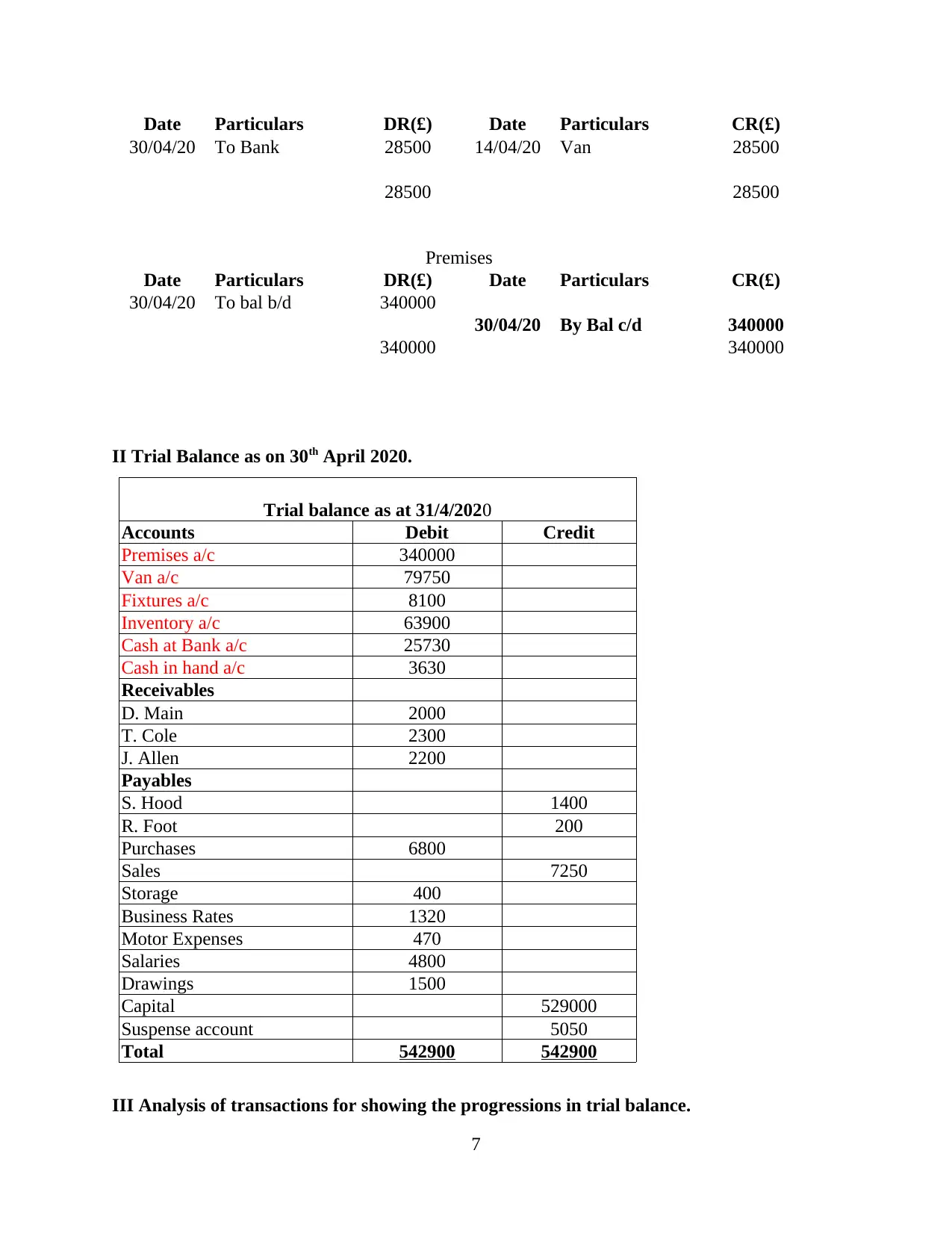
Date Particulars DR(£) Date Particulars CR(£)
30/04/20 To Bank 28500 14/04/20 Van 28500
28500 28500
Premises
Date Particulars DR(£) Date Particulars CR(£)
30/04/20 To bal b/d 340000
30/04/20 By Bal c/d 340000
340000 340000
II Trial Balance as on 30th April 2020.
Trial balance as at 31/4/2020
Accounts Debit Credit
Premises a/c 340000
Van a/c 79750
Fixtures a/c 8100
Inventory a/c 63900
Cash at Bank a/c 25730
Cash in hand a/c 3630
Receivables
D. Main 2000
T. Cole 2300
J. Allen 2200
Payables
S. Hood 1400
R. Foot 200
Purchases 6800
Sales 7250
Storage 400
Business Rates 1320
Motor Expenses 470
Salaries 4800
Drawings 1500
Capital 529000
Suspense account 5050
Total 542900 542900
III Analysis of transactions for showing the progressions in trial balance.
7
30/04/20 To Bank 28500 14/04/20 Van 28500
28500 28500
Premises
Date Particulars DR(£) Date Particulars CR(£)
30/04/20 To bal b/d 340000
30/04/20 By Bal c/d 340000
340000 340000
II Trial Balance as on 30th April 2020.
Trial balance as at 31/4/2020
Accounts Debit Credit
Premises a/c 340000
Van a/c 79750
Fixtures a/c 8100
Inventory a/c 63900
Cash at Bank a/c 25730
Cash in hand a/c 3630
Receivables
D. Main 2000
T. Cole 2300
J. Allen 2200
Payables
S. Hood 1400
R. Foot 200
Purchases 6800
Sales 7250
Storage 400
Business Rates 1320
Motor Expenses 470
Salaries 4800
Drawings 1500
Capital 529000
Suspense account 5050
Total 542900 542900
III Analysis of transactions for showing the progressions in trial balance.
7
⊘ This is a preview!⊘
Do you want full access?
Subscribe today to unlock all pages.

Trusted by 1+ million students worldwide
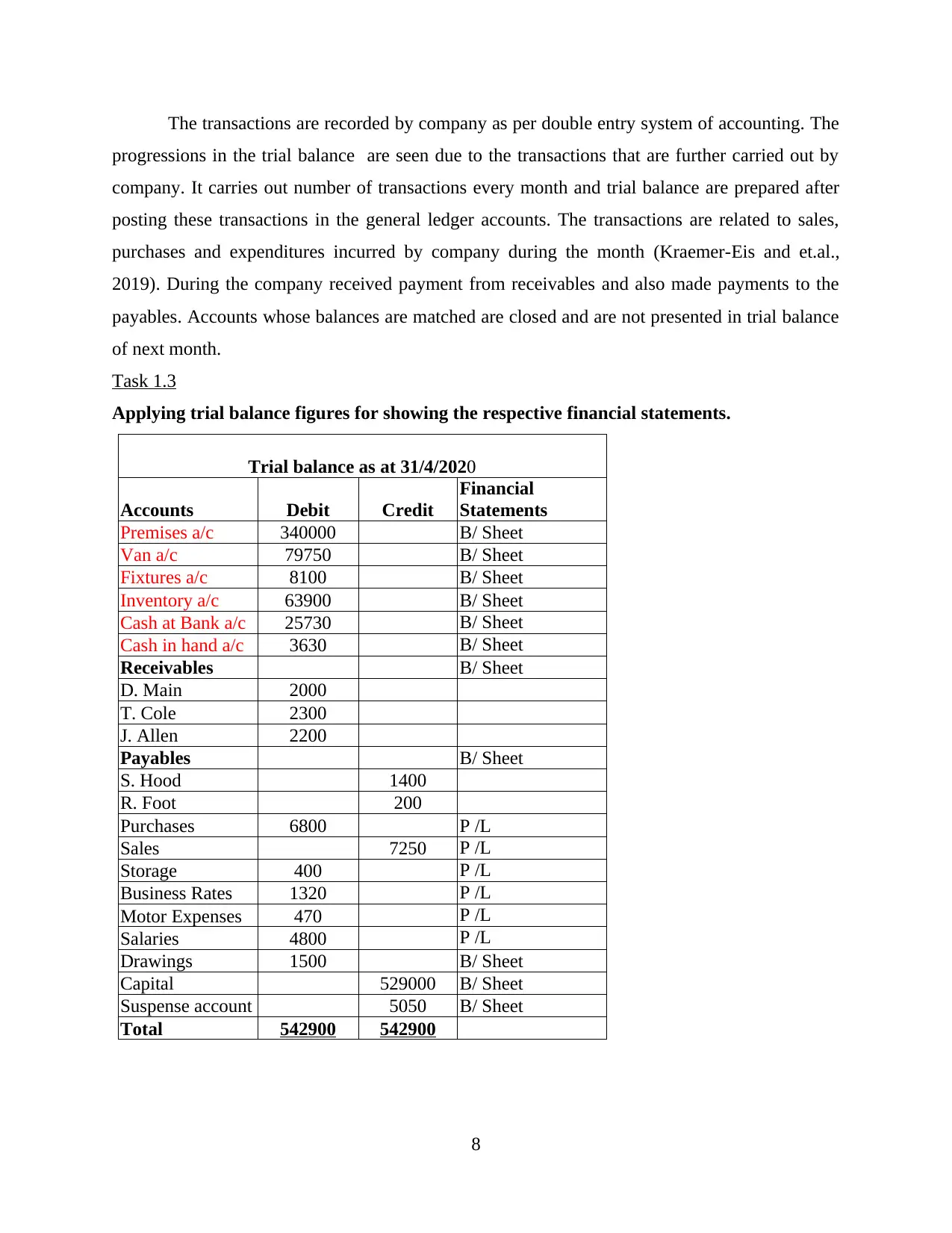
The transactions are recorded by company as per double entry system of accounting. The
progressions in the trial balance are seen due to the transactions that are further carried out by
company. It carries out number of transactions every month and trial balance are prepared after
posting these transactions in the general ledger accounts. The transactions are related to sales,
purchases and expenditures incurred by company during the month (Kraemer-Eis and et.al.,
2019). During the company received payment from receivables and also made payments to the
payables. Accounts whose balances are matched are closed and are not presented in trial balance
of next month.
Task 1.3
Applying trial balance figures for showing the respective financial statements.
Trial balance as at 31/4/2020
Accounts Debit Credit
Financial
Statements
Premises a/c 340000 B/ Sheet
Van a/c 79750 B/ Sheet
Fixtures a/c 8100 B/ Sheet
Inventory a/c 63900 B/ Sheet
Cash at Bank a/c 25730 B/ Sheet
Cash in hand a/c 3630 B/ Sheet
Receivables B/ Sheet
D. Main 2000
T. Cole 2300
J. Allen 2200
Payables B/ Sheet
S. Hood 1400
R. Foot 200
Purchases 6800 P /L
Sales 7250 P /L
Storage 400 P /L
Business Rates 1320 P /L
Motor Expenses 470 P /L
Salaries 4800 P /L
Drawings 1500 B/ Sheet
Capital 529000 B/ Sheet
Suspense account 5050 B/ Sheet
Total 542900 542900
8
progressions in the trial balance are seen due to the transactions that are further carried out by
company. It carries out number of transactions every month and trial balance are prepared after
posting these transactions in the general ledger accounts. The transactions are related to sales,
purchases and expenditures incurred by company during the month (Kraemer-Eis and et.al.,
2019). During the company received payment from receivables and also made payments to the
payables. Accounts whose balances are matched are closed and are not presented in trial balance
of next month.
Task 1.3
Applying trial balance figures for showing the respective financial statements.
Trial balance as at 31/4/2020
Accounts Debit Credit
Financial
Statements
Premises a/c 340000 B/ Sheet
Van a/c 79750 B/ Sheet
Fixtures a/c 8100 B/ Sheet
Inventory a/c 63900 B/ Sheet
Cash at Bank a/c 25730 B/ Sheet
Cash in hand a/c 3630 B/ Sheet
Receivables B/ Sheet
D. Main 2000
T. Cole 2300
J. Allen 2200
Payables B/ Sheet
S. Hood 1400
R. Foot 200
Purchases 6800 P /L
Sales 7250 P /L
Storage 400 P /L
Business Rates 1320 P /L
Motor Expenses 470 P /L
Salaries 4800 P /L
Drawings 1500 B/ Sheet
Capital 529000 B/ Sheet
Suspense account 5050 B/ Sheet
Total 542900 542900
8
Paraphrase This Document
Need a fresh take? Get an instant paraphrase of this document with our AI Paraphraser
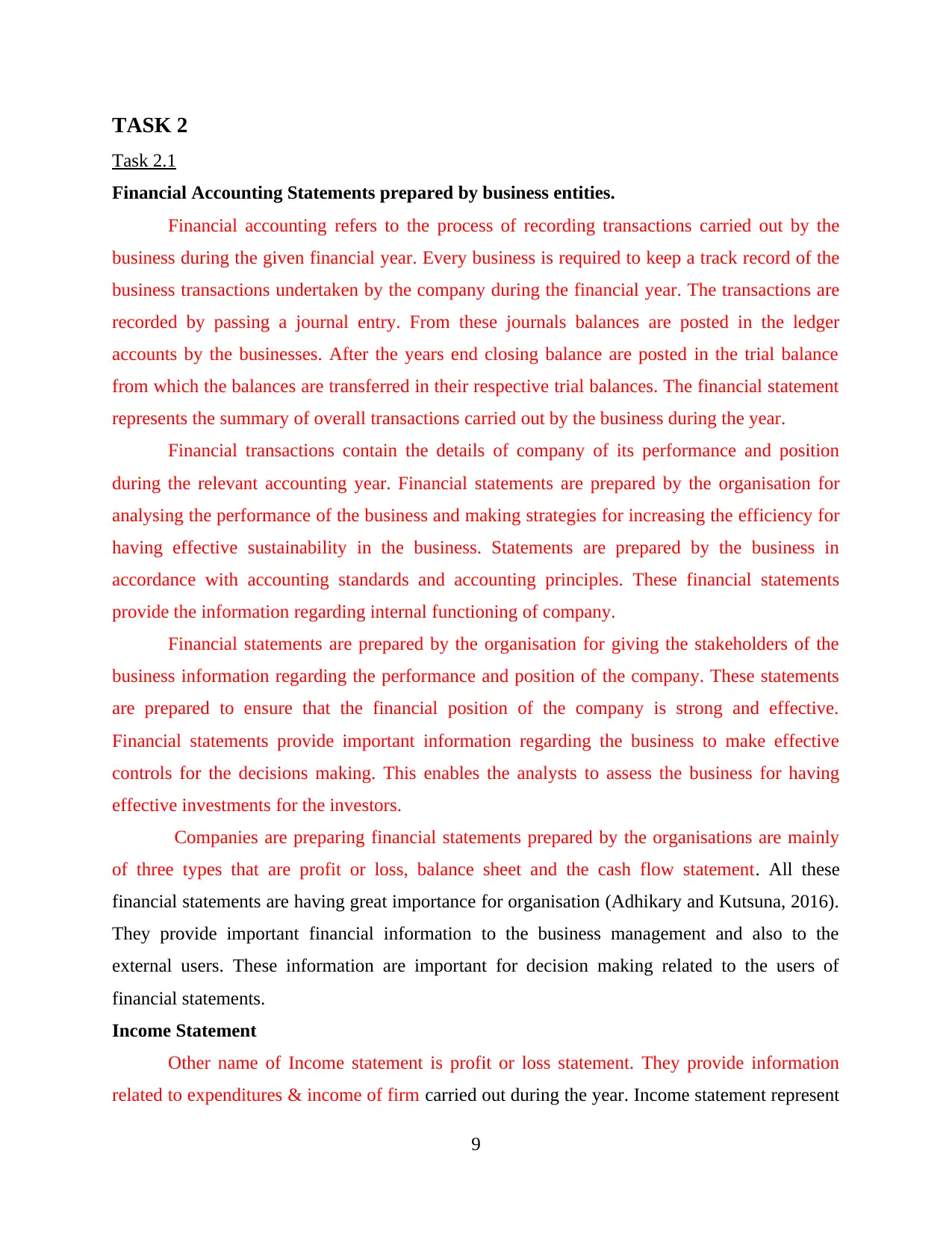
TASK 2
Task 2.1
Financial Accounting Statements prepared by business entities.
Financial accounting refers to the process of recording transactions carried out by the
business during the given financial year. Every business is required to keep a track record of the
business transactions undertaken by the company during the financial year. The transactions are
recorded by passing a journal entry. From these journals balances are posted in the ledger
accounts by the businesses. After the years end closing balance are posted in the trial balance
from which the balances are transferred in their respective trial balances. The financial statement
represents the summary of overall transactions carried out by the business during the year.
Financial transactions contain the details of company of its performance and position
during the relevant accounting year. Financial statements are prepared by the organisation for
analysing the performance of the business and making strategies for increasing the efficiency for
having effective sustainability in the business. Statements are prepared by the business in
accordance with accounting standards and accounting principles. These financial statements
provide the information regarding internal functioning of company.
Financial statements are prepared by the organisation for giving the stakeholders of the
business information regarding the performance and position of the company. These statements
are prepared to ensure that the financial position of the company is strong and effective.
Financial statements provide important information regarding the business to make effective
controls for the decisions making. This enables the analysts to assess the business for having
effective investments for the investors.
Companies are preparing financial statements prepared by the organisations are mainly
of three types that are profit or loss, balance sheet and the cash flow statement. All these
financial statements are having great importance for organisation (Adhikary and Kutsuna, 2016).
They provide important financial information to the business management and also to the
external users. These information are important for decision making related to the users of
financial statements.
Income Statement
Other name of Income statement is profit or loss statement. They provide information
related to expenditures & income of firm carried out during the year. Income statement represent
9
Task 2.1
Financial Accounting Statements prepared by business entities.
Financial accounting refers to the process of recording transactions carried out by the
business during the given financial year. Every business is required to keep a track record of the
business transactions undertaken by the company during the financial year. The transactions are
recorded by passing a journal entry. From these journals balances are posted in the ledger
accounts by the businesses. After the years end closing balance are posted in the trial balance
from which the balances are transferred in their respective trial balances. The financial statement
represents the summary of overall transactions carried out by the business during the year.
Financial transactions contain the details of company of its performance and position
during the relevant accounting year. Financial statements are prepared by the organisation for
analysing the performance of the business and making strategies for increasing the efficiency for
having effective sustainability in the business. Statements are prepared by the business in
accordance with accounting standards and accounting principles. These financial statements
provide the information regarding internal functioning of company.
Financial statements are prepared by the organisation for giving the stakeholders of the
business information regarding the performance and position of the company. These statements
are prepared to ensure that the financial position of the company is strong and effective.
Financial statements provide important information regarding the business to make effective
controls for the decisions making. This enables the analysts to assess the business for having
effective investments for the investors.
Companies are preparing financial statements prepared by the organisations are mainly
of three types that are profit or loss, balance sheet and the cash flow statement. All these
financial statements are having great importance for organisation (Adhikary and Kutsuna, 2016).
They provide important financial information to the business management and also to the
external users. These information are important for decision making related to the users of
financial statements.
Income Statement
Other name of Income statement is profit or loss statement. They provide information
related to expenditures & income of firm carried out during the year. Income statement represent
9
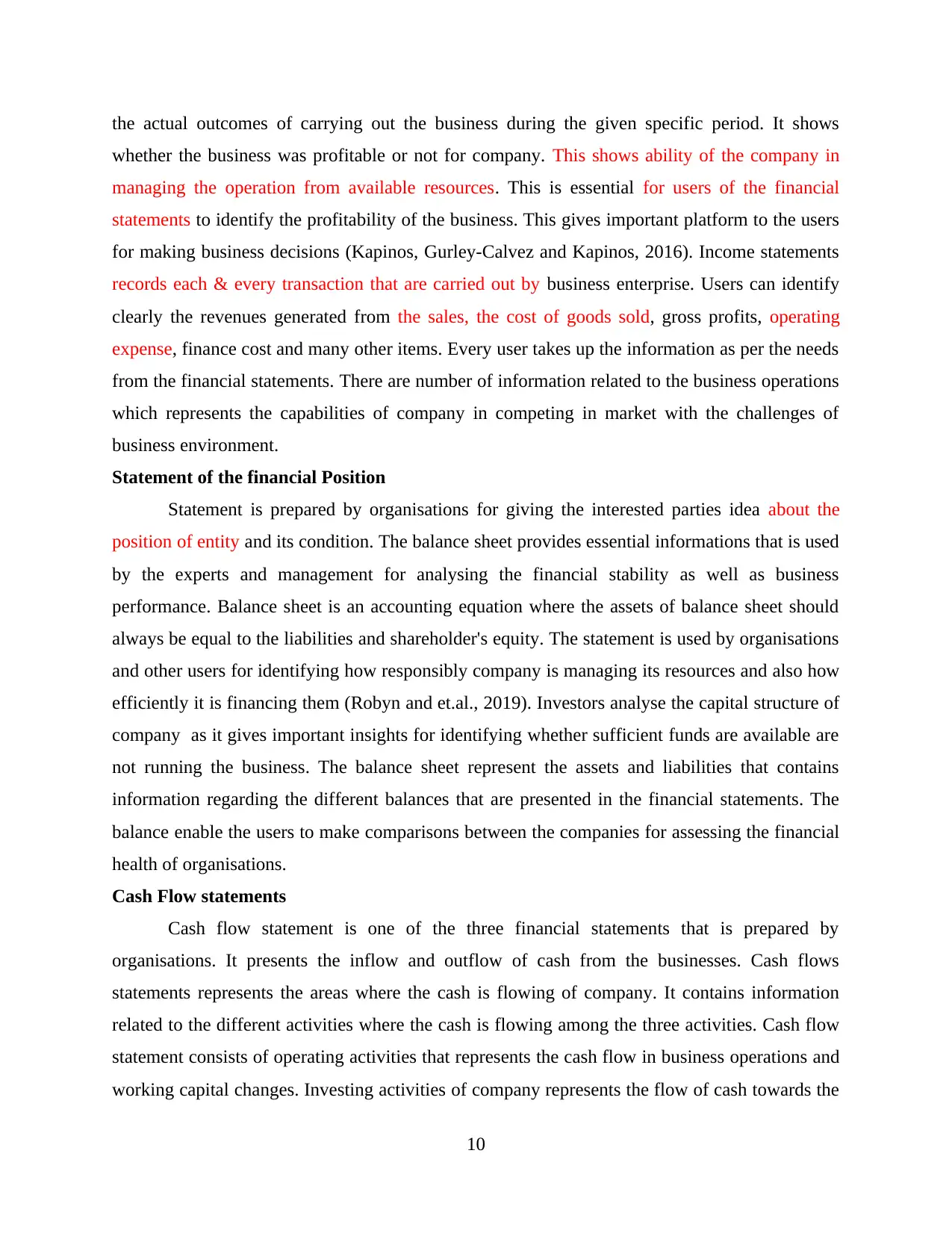
the actual outcomes of carrying out the business during the given specific period. It shows
whether the business was profitable or not for company. This shows ability of the company in
managing the operation from available resources. This is essential for users of the financial
statements to identify the profitability of the business. This gives important platform to the users
for making business decisions (Kapinos, Gurley-Calvez and Kapinos, 2016). Income statements
records each & every transaction that are carried out by business enterprise. Users can identify
clearly the revenues generated from the sales, the cost of goods sold, gross profits, operating
expense, finance cost and many other items. Every user takes up the information as per the needs
from the financial statements. There are number of information related to the business operations
which represents the capabilities of company in competing in market with the challenges of
business environment.
Statement of the financial Position
Statement is prepared by organisations for giving the interested parties idea about the
position of entity and its condition. The balance sheet provides essential informations that is used
by the experts and management for analysing the financial stability as well as business
performance. Balance sheet is an accounting equation where the assets of balance sheet should
always be equal to the liabilities and shareholder's equity. The statement is used by organisations
and other users for identifying how responsibly company is managing its resources and also how
efficiently it is financing them (Robyn and et.al., 2019). Investors analyse the capital structure of
company as it gives important insights for identifying whether sufficient funds are available are
not running the business. The balance sheet represent the assets and liabilities that contains
information regarding the different balances that are presented in the financial statements. The
balance enable the users to make comparisons between the companies for assessing the financial
health of organisations.
Cash Flow statements
Cash flow statement is one of the three financial statements that is prepared by
organisations. It presents the inflow and outflow of cash from the businesses. Cash flows
statements represents the areas where the cash is flowing of company. It contains information
related to the different activities where the cash is flowing among the three activities. Cash flow
statement consists of operating activities that represents the cash flow in business operations and
working capital changes. Investing activities of company represents the flow of cash towards the
10
whether the business was profitable or not for company. This shows ability of the company in
managing the operation from available resources. This is essential for users of the financial
statements to identify the profitability of the business. This gives important platform to the users
for making business decisions (Kapinos, Gurley-Calvez and Kapinos, 2016). Income statements
records each & every transaction that are carried out by business enterprise. Users can identify
clearly the revenues generated from the sales, the cost of goods sold, gross profits, operating
expense, finance cost and many other items. Every user takes up the information as per the needs
from the financial statements. There are number of information related to the business operations
which represents the capabilities of company in competing in market with the challenges of
business environment.
Statement of the financial Position
Statement is prepared by organisations for giving the interested parties idea about the
position of entity and its condition. The balance sheet provides essential informations that is used
by the experts and management for analysing the financial stability as well as business
performance. Balance sheet is an accounting equation where the assets of balance sheet should
always be equal to the liabilities and shareholder's equity. The statement is used by organisations
and other users for identifying how responsibly company is managing its resources and also how
efficiently it is financing them (Robyn and et.al., 2019). Investors analyse the capital structure of
company as it gives important insights for identifying whether sufficient funds are available are
not running the business. The balance sheet represent the assets and liabilities that contains
information regarding the different balances that are presented in the financial statements. The
balance enable the users to make comparisons between the companies for assessing the financial
health of organisations.
Cash Flow statements
Cash flow statement is one of the three financial statements that is prepared by
organisations. It presents the inflow and outflow of cash from the businesses. Cash flows
statements represents the areas where the cash is flowing of company. It contains information
related to the different activities where the cash is flowing among the three activities. Cash flow
statement consists of operating activities that represents the cash flow in business operations and
working capital changes. Investing activities of company represents the flow of cash towards the
10
⊘ This is a preview!⊘
Do you want full access?
Subscribe today to unlock all pages.

Trusted by 1+ million students worldwide
1 out of 24
Related Documents
Your All-in-One AI-Powered Toolkit for Academic Success.
+13062052269
info@desklib.com
Available 24*7 on WhatsApp / Email
![[object Object]](/_next/static/media/star-bottom.7253800d.svg)
Unlock your academic potential
Copyright © 2020–2025 A2Z Services. All Rights Reserved. Developed and managed by ZUCOL.

